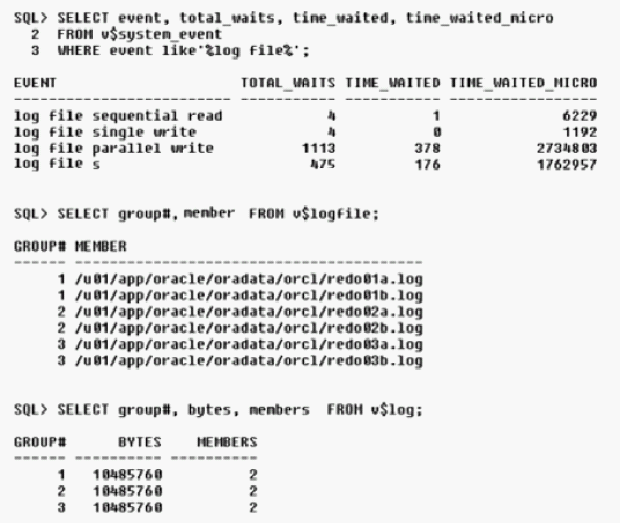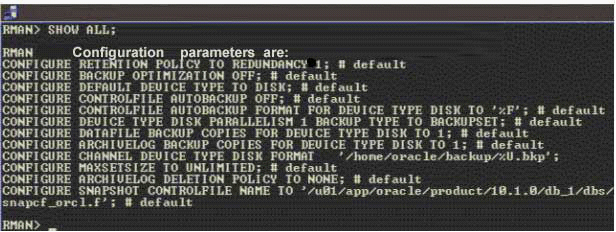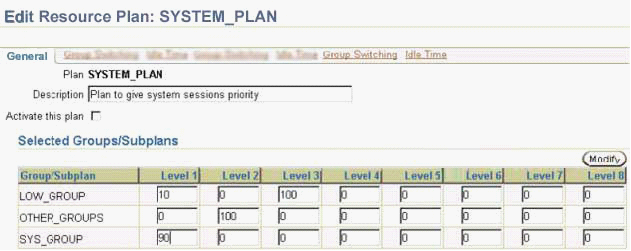Oracle 10g OCP 043 题库 1-40题 共185题
来源:互联网 发布:企业官网源码 编辑:程序博客网 时间:2024/04/16 20:02
1. You observe that a database performance has degraded over a period of time. While investigating the reason, you find the size of the database buffer cache is not large enough to cache all the needed data blocks. Which advisory component would you refer to, in order to determine that required size of the database buffer cache?
A. Memory Advisor
B. Segment Advisor
C. SQL Tuning Advisor
D. SQL Access Advisor
E. Automatic Database Diagnostic Monitor(ADDM)
Answer: A
Adequate physical memory has a significant impact on the performance of your Oracle Database. With its automatic memory management capabilities, Oracle Database can automatically adjust the memory distribution among the various SGA and PGA components for optimal performance. These adjustments are made within the boundaries of the total amount of memory that you allocate to the database.
ADDM periodically evaluates the performance of your database to determine performance problems. If ADDM finds that the current amount of available memory is inadequate and adversely affecting performance, then it can recommend that you increase memory allocations. You can select new memory allocations using the Memory Advisors.
Additionally, you can use the Memory Advisors to perform what-if analysis on the following:
The database performance benefits of adding physical memory to your database
The database performance impact of reducing the physical memory available to your database
With the Memory Advisors, you can obtain memory sizing advice as follows:
If automatic memory management is enabled, then you can get advice for setting the target amount of memory to allocate to the Oracle instance.
If automatic memory management is disabled and automatic shared memory management is enabled, then you can get advice on configuring the target sizes of the SGA and instance PGA.
If only manual shared memory management is enabled, then you can get advice on sizing the shared pool, buffer cache, and instance PGA.
http://download.oracle.com/docs/cd/E11882_01/server.112/e10897/montune.htm#ADMQS1034
2. Exhibit

In your production database, the total waits and the time waited for log file parallel write are significantly high. While investigating the reason, you find that there are three redo log groups with two members in each group, and all redo log members are places on a single physical disk. What action would you take to minimize the waits?
A. Start the log writer slave processes
B. Increase the number of redo log files
C. Increase the size of the redo log buffer.
D. Place the redo log files on the different disks.
E. Increase the number of log writer processes.
Answer: D
3. One of the tablespace is read-only in your database. The loss of all control file forced you to recreate the control file. Which operation do you need to perform after re-creating the control file and opening the database?
A. Drop and re-create the read-only tablespaces
B. Rename the read-only data file to their correct file names.
C. Change the tablespace status from read/write to read-only.
D. Re-create the read-only tablespace because it is automatically removed.
Answer: B
4. You have set some of the initialization parameters as:
DB_BLOCK_SIZE=8KB
SGA_MAX_SIZE=2GB
SGA_TARGET =0
SHARED_POOL_SIZE=120MB
DB_CHCHE_SIZE=896MB
STREAM_POOL_SIZE=0
LARGE_POOL_SIZE=110MB
Which two statements are correct?(Choose two).
A. You can not set a value for the DB_8K_CHCHE_SIZE parameter.
B. If you increase the size of the large pool to 120MB, then the memory allocated to the shared poll will be reduced to 110MB.
C. If the value for SGA_TARGET is changed to 1GB and SHARED_POOL_SIZE is 120MB, then memory cannot be taken from the shared pool, even if the shared pool has free space available.
D. If an application attempts to allocate more than 120MB from the shared pool and free space is available in the buffer pool, then the free space from the buffer pool is allocated to the shared pool.
Answer: AC
5. You are performing a block media recovery on the tools01.dbf data file in the SALES database using RMAN. Which two statements are correct in this scenario? (Choose two.)
A. You must ensure that the SALES database is mounted or open.
B. You must restore a backup control file to perform a block media recovery.
C. You must take the tools01.dbf data file offline before you start a block media recovery.
D. You must put the database in NOARCHIVELOG mode to perform a block media recovery.
E. You can perform only a complete media recovery of individual blocks, point-in-time recovery of individual data blocks is not supported.
Answer: A, E
6. Exhibit

You executed the following command to perform a backup of the
USERStablespace:
RMAN > BACKUP TABLESPACE USERS;
Which type of backup would this command perform?
A. backup set
B. image copy
C. incremental backup
D. None; the user receives an error indicating that the backup type must be specified.
Answer: A
7. In your database, online redo log files are multiplexed and one of the members in a group is lost due to media failure?
How would you recover the lost redo log member?
A. import the database from the last export
B. restore all the members in the group from the last backup
C. drop the lost member from the database and then add a new member to the group
D. restore all the database files from the backup and then perform a complete recovery
E. restore all the database files from the backup and then perform an incomplete recovery
Answer: C
Redo group里如果有多个成员,那么他们是冗余的。 每个成员里的内容都一样,所以删除在添加一个即可。
8. You are using Oracle Database 10g. Which statement regarding an incomplete recovery is true?
A. You do not need to restore all the data files.
B. You do not need to open the database with the RESETLOGS operation
C. You do not need to perform a full backup after the RESETLOGS operation.
D. You do not need to recover all the data files to the same system change number (SCN).
Answer: C
9. Exhibit

View the Exhibit and examine the Resource Manager settings for the groups at different levels.
Which two effects would be the result of this setting? (Choose two.)
A. The members of LOW_GROUP would get more priority than those of OTHER_GROUPS.
B. The members of SYS_GROUP would get most of the CPU allocation at level 1.
C. The members of LOW_GROUP would get most of the CPU allocation because it has CPU allocation at two different levels.
D. The members of LOW_GROUP would get no CPU allocation at level1 if the members of OTHER_GROUPS are using all the CPU at level 2.
E. The members of SYS_GROUP would get no CPU allocation at level 1 if the members of OTHER_GROUPS are using all the CPU at level 2.
Answer: A, B
10. The current time zone for one of the user sessions is set to the database local time zone. For one application, the user session requires the time zone to be set to the local operating system time zone without affecting other user sessions.
Which two solutions could the user implement to achieve this objective? (Choose two.)
A. use the ALTER SYSTEM command to change the time zone
B. use the ALTER SESSION command to change the time zone
C. use the ALTER DATABASE command to change the time zone
D. set the value for the operating system variable ORA_SDTZ on the client machine
E. set the value for the operating system variable ORA_SDTZ on the database server machine
Answer: B, D
11. You work as a database administrator at Certkiller .com. Your database is open and running in ARCHIVELOG mode. You take RMAN full backups every Sunday night. On Monday morning, while querying the user1.employees table, you receive the following error message:
01578: ORACLE data block corrupted (file # 5, block # 51)
ORA-01110: data file 5:
'/u01/app/oracle/oradata/orcl/example01.dbf'
You need to rectify the corruption while ensuring the following:
The data file should remain online.
The mean time to recover (MTTR) should be minimal.
You are not using a backup control file and all the archived logs are accessible. Which option would you choose?
A. flash back the corrupted blocks
B. use the DBMS_REPAIR package
C. use the RMAN TSPITR command
D. use the RMAN BLOCKRECOVER command
E. use the RESTORE DATABASE and RECOVER DATABASE commands
F. investigate the time at which the corruption occurred and perform a point-in-time recovery
Answer: D
12. You are working on an Oracle Database 10g database. You enabled the Flashback Database feature. Which two statements regarding flashback logs are true? (Choose two.)
A. Flashback logs are not archived.
B. Flashback logs are maintained in redo log files.
C. Flashback logs are maintained in the Flash Recovery Area.
D. Flashback logs are used to maintain Flashback Database related errors.
E. Flashback logs need to be cleared manually after you disable Flashback Database.
Answer: A, C
13. You executed the following query:
SELECT operation, undo_sql, table_name FROM flashback_transaction_query;
Which statement is correct regarding the query output?
A. It would return information regarding only the last committed transaction.
B. It would return only the active transactions in all the undo segments in the database.
C. It would return only the committed transactions in all the undo segments in the database.
D. It would return both active and committed transactions in all the undo segments in the database.
E. It would return information regarding the transactions that began and were committed in the last 30 minutes.
Answer: D
FLASHBACK_TRANSACTION_QUERY displays information about all flashback transaction queries in the database. The database must have at least minimal supplemental logging enabled to avoid unpredictable behavior.
http://download.oracle.com/docs/cd/E11882_01/server.112/e10820/statviews_5113.htm#REFRN29086
14. Consider the following configuration:
/devices/D1 is a member of disk group dgroupA.
/devices/D2 is a member of disk group dgroupA.
/devices/D3 is a member of disk group dgroupA.
You plan to add a new disk, /devices/D4,to the disk group dgroupA.
You execute the following command:
SQL> ALTER DISKGROUP dgroupA ADD DISK '/devices/D*';
Which task would be accomplished by the command?
A. The command adds the new disk, D4, to the disk group.
B. The command would result in an error because the is no disk by the name "'/devices/D*'"
C. The command will be ignored because disks starting with "D" are already members of the disk group.
D. The command would result in an error because no wildcard characters can be used in the disk name.
E. The command first detaches all the member disks starting with "D", and the reattaches them including the new disk.
Answer: A
15. You work as a database administrator at Certkiller .com. In your production database there is a job, CALC_STAT, which has been scheduled to run every Friday at 5.00 p.m. CALC_STAT updates the optimizer statistics for the objects owned by the APPS schema. You want the task to be generic, there by allowing users to modify the attributes of the task at run time without affecting the original task.
Which component of Oracle Scheduler must you define to achieve this?
A. Window
B. Program
C. Job class
D. Window group
Answer: B
16. Immediately after adding a new disk to or removing an existing disk from an Automatic Storage Management (ASM) instance, you find that the performance of the database decreases initially, until the addition or removal process is completed.
Performance then gradually returns to normal levels. Which two activities could you perform to maintain a consistent performance of the database while adding or removing disks? (Choose two.)
A. increase the number of checkpoint processes
B. define the POWER option while adding or removing the disks
C. increase the number of DBWR processes by setting up a higher value for DB_WRITER_PROCESSES
D. increase the number of slave database writer processes by setting up a higher value for DBWR_IO_SLAVES
E. increase the number of ASM Rebalance processes by setting up a higher value for ASM_POWER_LIMIT during the disk addition or removal
Answer: B, E
17. The current time is 12:00 noon. You want to recover the USERS tablespace from a failure that occurred at 11:50 a.m. You discover that the only member of an unarchived redo log group containing information from 11:40 a.m. onwards is corrupt.
With reference to this scenario, if you are not using Recovery Manager (RMAN),
which recovery method would you use?
A. time-based recovery
B. log sequence recovery
C. cancel-based recovery
D. change-based recovery
Answer: C
18. You lost the PRODSTD tablespace, which was read/write. The tablespace was read-only when the last backup was performed. How would you recover the tablespace?
A. restore the tablespace from the backup; there is no need to apply the redo information
B. restore the full database to recover the data up to the point when you performed the backup
C. restore the tablespace from the backup and then perform a recovery using the backup control file
D. restore the tablespace from the backup and then recover the tablespace; all the redo information from the point when the tablespace was made read/write is applied
Answer: D
19. You are using an Automatic Storage Management (ASM) instance to manage the files of your production database. You have two disk groups, DG1and DG2 with one device each. In the parameter file of the production database, the following parameters have been specified:
DB_CREATE_ONLINE_LOG_DEST_1 = '+dg1'
DB_CREATE_ONLINE_LOG_DEST_2 = '+dg2'
What would be the impact of this setting?
A. When a new log group is added, it would have one member in each disk group.
B. When a new log group is added, it would have two members in each disk group.
C. When a new tablespace is added, it would have one data file in each disk group.
D. When a new log file is added, it would have one member spread across the disk groups.
Answer: A
20. An RMAN backup job fails, displaying the following error:
ORA-19809: limit exceeded for recovery files
Your analysis shows that the Flash Recovery area is full. Which two actions could you take to resolve the error and avoid this error in the future? (Choose two.)
A. take the backup of the flash recovery area less frequently
B. increase the value of the UNDO_RETENTION initialization parameter
C. change the value of the WORKAREA_SIZE_POLICY initialization parameter to AUTO
D. change the backup retention policy to retain the backups for a smaller period of time
E. increase the value of the DB_RECOVERY_FILE_DEST_SIZE initialization parameter
F. increase the value of the CONTROL_FILE_RECORD_KEEP_TIME initialization parameter
Answer: D, E
21. Your database operates in ARCHIVELOG mode. User-managed consistent backups are performed every Sunday night.
On Tuesday, client A drops a table at 8:00 a.m. as follows:
SQL> DROP TABLE cust_ord PURGE;
Table dropped.
Client B executes a query at 9:00 a.m. on the same table as follows:
SQL> SELECT * FROM cust_ord;
SELECT * FROM cust_ord
*
ERROR at line 1:
ORA-00942: table or view does not exist
Client B needs the dropped table and reports the problem to you.
With reference to this scenario, which action should you take?
A. retrieve the table by using the flashback feature
B. restore all the data files from last Sunday's backup and then perform a time-based recovery
C. restore all the data files from last Sunday's backup and then perform a log sequence recovery
D. restore all the data files from last Sunday's backup and then perform a cancel-based recovery
E. restore from last Sunday's backup only data files that belong to the tablespace in which the table was stored and then perform a complete recovery
Answer: B
22. You performed an incomplete recovery on your Oracle Database 10g database using the following command:
SQL> RECOVER DATABASE
2 UNTIL TIME '2004-08-05:12:10:03'
3 USING BACKUP CONTROLFILE;
In which situation would the above recovery be required?
A. A user table was lost at the specified time.
B. A redo log file was lost at the specified time.
C. The backup control file is on a faster disk than the current one.
D. The current control file has a different path compared with the intended time of recovery.
E. The current control file does not match the physical structure of the database at the intended time of recovery.
Answer: E
23. While creating a job class using the DBMS_SCHEDULER package, you set the logging level to LOGGING_RUNS. What would be the impact of this setting?
A. Oracle Scheduler would write detailed information to the job log for each run of each job in the job class.
B. Oracle Scheduler would write detailed information to the job log for the first run of each job in the job class.
C. Oracle Scheduler would write detailed information to the job log for each run of only the first job in the job class.
D. Oracle Scheduler would write detailed information for all operations performed on all jobs in the job class.
Answer: A
Oracle 10g Scheduler 特性
http://blog.csdn.net/tianlesoftware/archive/2009/10/23/4715218.aspx
24. You are designing an application for Certkiller .com and you have been asked to design a database table to facilitate monthly bill generation. The bill would include details of customer calls, listed in chronological order.
Which method would you follow to achieve this objective without increasing the overhead of sorting the rows?
A. create a hash cluster to store the data
B. create an index cluster to store the data
C. create a partitioned table to store the data
D. create a sorted hash cluster to store the data
E. create a heap table with rowid to store the data
Answer: D
25. You set the recovery window to seven days and the backup optimization to ON using the CONFIGURE command of Recovery Manager (RMAN). The most recent backup of the TOOLStablespace to disk was taken on January 3. The TOOLStablespace is read-only. On February 21, when you execute a command to back up all the tablespaces to disk, you find that RMAN backs up the TOOLStablespace also, even though the contents of the tablespace have not changed after the backup on January 3. Because there are no changes made to the TOOLStablespace, you decide that the tablespace should not be backed up by RMAN. What can you do to skip backing up the TOOLStablespace without changing the current backup optimization setting?
A. configure a default device for RMAN backups
B. temporarily disable the retention policy for RMAN backups
C. configure automatic channel allocation for RMAN backups
D. use the CONFIGURE command to reconfigure the recovery window to 60 days
Answer: D
26. Exhibit:

You want to configure the Flashback Database feature and retain flashback logs for three days.
The steps used in this process are displayed in the exhibit.
In what sequence would you need to perform these steps to enable the Flashback Database feature?
A. D, C, A, B, E
B. D, A, C, B, E
C. B, D, C, E, A
D. D, B, E, C, A
Answer: A
27. In which scenarios would you rebuild an index? (Choose all that apply.)
A. when you need to disable the index usage
B. when you need to change storage options
C. when you need to enable index monitoring
D. when you need to move the index to another tablespace
Answer: B, D
28. You enabled Automatic Shared Memory Management. The initialization parameters are set as shown below:
SGA_TARGET= 10GB
SGA_MAX_SIZE = 14GB
STREAMS_POOL_SIZE = 1GB
SHARED_POOL_SIZE = 3GB
Which two statements are correct in this scenario? (Choose two.)
A. A maximum of 3 GB can be allocated to shared pool.
B. The value for SGA_TARGET can be increased up to a maximum of 15 GB.
C. A total of 14 GB memory will be allocated to the automatically tuned memory components.
D. Increasing the value for SGA_TARGET will automatically increase the memory allocated for STREAMS_POOL_SIZE.
E. Increasing the value for SGA_TARGET to 12 GB will automatically increase the memory allocated to autotuned parameters.
F. Reducing the value for SGA_TARGET to 9 GB will automatically decrease the memory allocated to shared pool from 3 GB to 2 GB.
Answer: B, E
29. Which statement correctly describes the change tracking writer (CTWR) background process?
A. It keeps track of changes in the background processes.
B. It records the system change number (SCN) in the control file.
C. It writes audit records for user changes to the change tracking file.
D. It records any changes to the listened configuration in the listener.ora file.
E. It records any changes to the database parameters in the change tracking file.
F. It records the physical location of all the changes that are made to the database in the change tracking file.
Answer: F
Explanation:
This is a new process Change Tracking Writer (CTWR) which works with the new block changed tracking features in 10g for fast RMAN incremental backups.
This is a clarification of the documentation for sizing the Block Change Tracking File.
Block Change Tracking is used to optimize incremental backups. A new file is introduced:
- Changed blocks are tracked by the CTWR background process as redo is generated
- Database backups automatically use the change tracking file Sizing of this file is important, and even though you can use
V$BLOCK_CHANGE_TRACKING view to monitor the usage, it may in some cases not be easy to change the size, ie when using raw devices.
30. You work as a database administrator at Certkiller .com. In your production database, you observe that users' transactions are consuming a lot of resource and you plan to impose resource restrictions by using Resource Manager. For which three resources can you enable usage restrictions by using Resource Manager? (Choose three.)
A. CPU usage
B. degree of parallelism
C. number of open cursors
D. number of sorts performed
E. idle time for blocking sessions
F. number of disk I/O operations performed
G. number of memory I/O operations performed
Answer: A, B, E
31. You have specified the warning and critical threshold values of an application tablespace to be 60% and 70% respectively. From the tablespace space usage metrics, you find that the actual space usage has reached the specified warning threshold value, but no alerts have been generated. What could be the reason for this?
A. The EVENT parameter was not set.
B. The SQL_TRACE parameter is set to FALSE.
C. The Enterprise Manager Grid Control is not used.
D. The STATISTICS_LEVEL parameter is set to BASIC.
E. The TIMED_STATISTICS parameter is set to FALSE.
Answer: D
32. You executed the following command in Recovery Manager (RMAN) against your Oracle 10g database:
RMAN> REPORT NEED BACKUP days 3;
What would be the output of this command?
A. a list of files that require a backup within three days
B. a list of files that have not been backed up for three days
C. a list of files that RMAN recommends be backed up only once in every three days, based on low volatility
D. a list of files for which a backup has already been performed and may need a backup after three days
Answer: B
33. Your database operates in ARCHIVELOGmode. The redo log files are not multiplexed and one of the online redo logs is missing. The missing redo log sequence, 230, is not archived and it contained information from 10:35 a.m. onwards. The current time is 11:00 a.m. Because of a disk crash, you executed the following command to perform an incomplete recovery:
RMAN> RUN {
2> SET UNTIL SEQUENCE 230 THREAD 1;
3> ALTER DATABASE MOUNT;
4> RESTORE DATABASE;
5> RECOVER DATABASE;
6> ALTER DATABASE OPEN RESETLOGS;
7> };
With reference to this scenario, which statement is true?
A. RMAN recovers up to log sequence 230, but not including 230.
B. RMAN returns an error because the log sequence number mentioned in the command should be 229.
C. RMAN returns an error because the log sequence number mentioned in the command may never be missing.
D. RMAN recovers up to and including log sequence 229 but then returns an error because log sequence 230 is missing.
Answer: A
34. In your database, all the tablespaces are locally managed. You started Recovery Manager (RMAN) using recovery catalog and restored the control file by using the following command:
RMAN> RESTORE CONTROLFILE;
Which two operations do you need to perform after restoring the control file from backup? (Choose two.)
A. shut down and restart the instance
B. add new tempfiles to the temporary tablespaces after recovery
C. perform a media recovery and open the database with the RESETLOGS option
D. perform a media recovery and bring the database to NOARCHIVELOG mode
Answer: B, C
35. While designing your database, you have created the EMPLOYEES table as an index-organized (IOT). You want to create a bitmap index on the JOD_ID column to make queries faster. Which task must have been completed so that you are able to create the bitmap index?
A. A primary key must have been created.
B. A mapping table must have been created.
C. An overflow tablespace must have been specified.
D. The PCTTHRESHOLD option must have been specified.
Answer: B
36. Exhibit

One of the important tables in the USERS tablespace was dropped and purged from the recycle bin at 9:00 a.m. You noticed this
at 11:00 a.m. and you want to perform an incomplete recovery to recover the table. Which statement is true?
A. You must recover all data files to the required system change number (SCN).
B. You must recover all data files, except those that are offline, to the required SCN.
C. You must recover all data files belonging to the USERS tablespace to the required SCN.
D. You cannot recover all data files because segment space management is performed manually for the undo tablespace.
Answer: B
37. You work as a database administrator at Certkiller .com. Your production database uses an Automatic Storage Management (ASM) instance to manage its files. You want to add a new disk group to the ASM instance to manage the increased data load.
What action would you perform to include the new disk group in the ASM instance without causing any impact on the currently connected users?
A. mount the new disk group in the ASM instance
B. restart the ASM instance and the production database instance
C. register the new disk groups in the production database instance
D. restart the ASM instance without restarting the production database instance
E. include the new disk group in the ASM_DISKSTRING parameter in the parameter file and restart the ASM instance
Answer: A
38. The DB_BLOCK_CHECKING initialization parameter is set to TRUE. What would be the result of this setting on the data
blocks being written to the datafiles, every time the DBWn writes?
A. The Oracle database will check all data blocks by going through the data on each block, making sure the data is self-consistent.
B. The DBWn and the direct loader will calculate a checksum and store it in the cache header of every data block when writing it to disk.
C. The Oracle database will check data blocks belonging to the SYSTEM tablespace only, by going through the data on each block, making sure the data is self-consistent.
D. The Oracle database will check data blocks belonging to the SYSAUX tablespace only, by going through the data on each block, making sure the data is self-consistent.
E. The Oracle database will check data blocks in the SYSTEM and SYSAUX tablespaces only, by going through the data on each block, making sure the data is self-consistent.
Answer: A
39. In your production database you want to use an Automatic Storage Management (ASM) instance to manage the database files. Which option would you use to migrate the database files from a non-ASM instance to an ASM instance?
A. Oracle Migration Assistant
B. Recovery Manager (RMAN)
C. Oracle Data Pump Export and Import
D. conventional Oracle Export and Import
E. operating system utilities to copy the files to the ASM instance
Answer: B
40. In the parameter file of your production database, the CONTROL_FILE_RECORD_KEEP_TIME parameter is set to 31. What would be the impact of this setting on the backup that is being performed by using Recovery Manager (RMAN)?
A. The backup would be retained on the media for 31 days.
B. The backup would be maintained in the recovery catalog for 31 days.
C. The backup metadata would be retained in the control file for 31 days.
D. The backup metadata would be maintained in the recovery catalog for 31 days.
E. Automatic backups of the control file will be retained in the flash recovery area for 31 days.
Answer: C
------------------------------------------------------------------------------
Blog: http://blog.csdn.net/tianlesoftware
网上资源: http://tianlesoftware.download.csdn.net
相关视频:http://blog.csdn.net/tianlesoftware/archive/2009/11/27/4886500.aspx
DBA1 群:62697716(满); DBA2 群:62697977(满)
DBA3 群:63306533; 聊天 群:40132017
- Oracle 10g OCP 043 题库 1-40题 共185题
- Oracle 10g OCP 043 题库 1-40题 共185题 .
- Oracle 10g OCP 043 题库 141-185题 共185题
- Oracle 10g OCP 043 题库 141-185题 共185题
- Oracle 10g OCP 043 题库 41-90题 共185题
- Oracle 10g OCP 043 题库 91-140题 共185题
- Oracle 10g OCP 043 题库 41-90题 共185题
- Oracle 10g OCP 043 题库 91-140题 共185题
- Oracle 10g OCP 042 题库 1-30 题 共168题
- Oracle 10g OCP 042 题库 1-30 题 共168题
- Oracle 10g OCP 042 题库 31-70 题 共168题
- Oracle 10g OCP 042 题库 71-120 题 共168题
- Oracle 10g OCP 042 题库 121-166题 共168题
- Oracle 10g OCP 042 题库 121-166题 共168题
- Oracle 10g OCP 042 题库 31-70 题 共168题
- Oracle 10g OCP 042 题库 71-120 题 共168题
- Oracle 10g OCP 042 题库 121-166题 共168题
- oracle 10g OCP
- 松鼠有错吗
- OAF中从弹性域获取值的明细页面
- 由经纬度计算Google卫星地图中瓦片Tile的地址
- 什么是脏读、不可重复读、幻读
- Linux网卡驱动分析
- Oracle 10g OCP 043 题库 1-40题 共185题
- 彻底明白Java语言中的IO系统
- google map 瓦片地图算法
- fcntl函数
- CreateProcess注入方法
- object-c 学习小记
- 电子线路基础 15 -----第 15 讲笔记
- Ado.net 用法浅析 (Sql Server)
- symbian中socket实现HTTP流程


